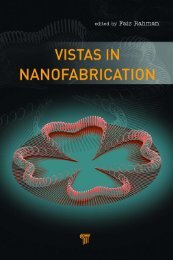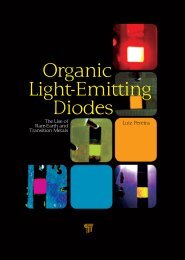Download PDF - Pan Stanford Publishing
Download PDF - Pan Stanford Publishing
Download PDF - Pan Stanford Publishing
- No tags were found...
You also want an ePaper? Increase the reach of your titles
YUMPU automatically turns print PDFs into web optimized ePapers that Google loves.
ContentsxviiPrefaceMolecular imprinting is now established as an indispensable toolfor separation and sensor technologies. The most popular schemeto realize the molecular imprinting concept is probably the crosslinkingof linear polymers in the presence of template molecules.Three-dimensional cavities would be created in the polymernetwork after the removal of template molecules. Unfortunately,the conformational adaptability of linear polymers is limited, andtemplate molecules and the surrounding polymer chains cannotproduce best molecular fitting in most cases. Molecular fitting bycommonly employed imprinting materials is less than satisfactorycompared with polypeptide chains of protein molecules. Superiorthree-dimensional fit of active sites of enzyme molecules and theirspecific substrates are truly remarkable.Some of the inorganic chains are much more flexible than organicchains. For example, rotational and bending motions of metal–oxygenbonds are more facile than those of carbon–carbon bonds. Thisfact implies that metal oxide gels provide better molecular fittingwith template molecules. In fact, the first example of molecularimprinting was reported in 1931 for silica matrix, as mentioned inChapter 1. The use of inorganic matrices became much expandedin recent years and now occupies a significant fraction of molecularimprinting studies.This handbook reflects this situation and attempts to survey therecent advances of molecular imprinting in inorganic and organicmatrices in a combined form. The functional aspect is more or lessfocused on sensor applications. Such applications have becomeincreasingly important in relation to environmental and biomedicalissues, as summarized as Parts 3 and 4, respectively. The discussionin Chapter 1 will help grasp the pros and cons of inorganic matricesrelative to organic matrices, and Part 5 provides a patent-basedmarket analysis of molecular imprinting technology.We are grateful to Mr. <strong>Stanford</strong> Chong of <strong>Pan</strong> <strong>Stanford</strong> <strong>Publishing</strong>for his continuous encouragement during the preparation of thishandbook. Many thanks also to our wives, who showed splendidperseverance towards the absent (minded) husbands.
















